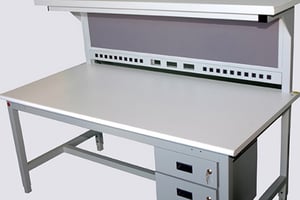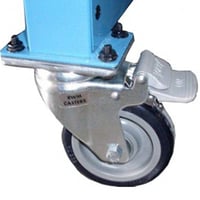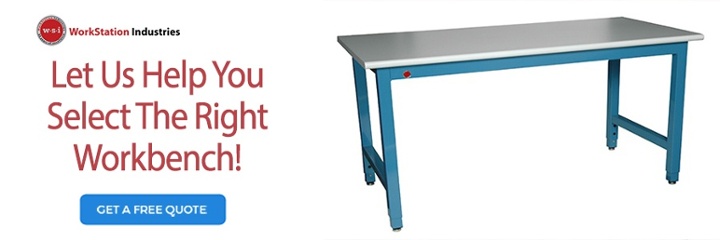Having the ability to customize your industrial workbench is a great step toward improving the safety, efficiency and workflow of your space.
However, knowing which customization opportunities to take advantage of is a whole other story.
One custom industrial workbench will likely look different than another, based on a facility’s applications, worker needs and budget. To help you determine which customizations are key to improving your workspace, below are five must-haves you won’t want to pass up.
1. The Right Countertop
 The type of material you choose for the countertop on your industrial workbench is one of the most important - if not the most important - decision you will make when customizing your product.
The type of material you choose for the countertop on your industrial workbench is one of the most important - if not the most important - decision you will make when customizing your product.
With harsh conditions often found in laboratories or manufacturing settings, it’s essential to choose a material that can withstand high temperatures, exposure to chemicals and other extreme elements.
But how do you decide which top to use for your workbench? It often comes down to several factors, but primarily your current application, any future applications and cost.
Here are a few to consider:
Phenolic Resin
How they are crafted: By layering natural kraft paper that has been saturated with phenolic resin and processed under high heat
High resistance to: Bacteria, chemicals, fungus, moisture, scratches
Moderately resistant to: Corrosion (moderate to high)
Other notes: Can withstand heat exposure up to 350 degrees F, mid-price, not flame-retardant
Best applications: Biological, chemical, clinical and analytical labs
Epoxy Resin
How they are crafted: Made with a mixture of materials and then cured into a solid product
High resistance to: Bacteria, fungus, corrosion, chemicals, water, moisture, scratches
Other notes: Can withstand continuous heat exposure above 350 degrees F, high price, flame-retardant
Best applications: Extreme lab conditions since it is the most durable of materials, such as biological science, industrial testing, medical, microbiology, and research and development
Stainless Steel
How they are crafted: Made of low carbon steel constructed with chromium and nickel
High resistance to: Bacteria, fugus, water and moisture
Moderately resistant to: Chemicals, corrosion
Other notes: Can withstand continuous heat exposure above 1500 degrees F (but may discolor at prolonged high temperatures), high price, can dent easily on impact
Best applications: Biological science, food testing, hospitals, pharmaceutical labs
Chemical Resistant Laminate
How they are crafted: By applying a melamine resin over decorative surface paper, which is then bonded to a core of kraft papers impregnated with phenolic resin
High resistance to: Chemicals
Other notes: Can withstand heat exposure up to 275 degrees F, mid-price, low resistance to other harsh conditions like bacteria, corrosion and fungus
Best applications: Beauty products, dental, pathology labs, product testing, urology labs
High Pressure Laminate
How they are crafted: By applying a melamine resin over decorative surface paper, which is then bonded to a core of kraft papers impregnated with phenolic resin
High resistance to: Not resistant to chemicals
Other notes: Can withstand heat exposure up to 275 degrees F, low-price, low resistance to any harsh conditions outlined above
Best applications: Product testing, technology labs
To read more about these, check out our article, Top 5 Materials To Consider For Your Lab Countertops.
2. Space-Saving Features
 Now that you’ve chosen the right countertop, another must-have is space-saving features.
Now that you’ve chosen the right countertop, another must-have is space-saving features.
Adding storage and other space-saving options to an industrial workbench is a great way to help your employees stay organized while removing the need for taking up additional expensive space.
Here are some features to consider:
- Utility drawers, which can come in a variety of sizes and configurations
- Shelving, which can be installed below or above the work surface
- Upper storage cabinets, which can move with the workstation
- Articulating monitor arms, which can accommodate flat screens and laptops
- Keyboard trays and CPU holders, which can be fixed or adjustable
- Pegboards, which can be added between the uprights to attach tools
- Bin rails or panels, which store parts and accessories
Keep in mind when choosing drawers for a workbench that you will have to decide whether you want them to lock or not, especially if the drawers will be used to store chemicals.
3. Ergonomically-Friendly Design
When putting together your custom industrial workbench, don’t forget the benefits of including an ergonomically-friendly design.
Workplace injuries aren’t limited to accidents or lifting incidents. In fact, some of the most recently available data from the U.S. Bureau of Labor Statistics shows sprains, strains and tears are among the leading types of injuries in manufacturing.
What does that mean for the pieces of industrial furniture you buy for your facility? Incorporating ergonomics into an industrial workbench design is important since
However, for many workers in the manufacturing industry, sitting or standing in one place is often part of the job. Ergonomics focuses on refining a product’s design so that it is better optimized for human use. In the end, this increases productivity and boosts safety in the workplace.
Workbenches, for example, can be designed to allow the user to sit or stand simply by using a manual, hand crank or electrical control. Drawers are designed to offer a higher level of accessibility so that workers do not have to reach unnaturally for them.
Even industrial furniture chairs can help support employees who spend long periods of time sitting by including sturdy frames, adjustable height capabilities, and comfortable backrests and seats in their design.
4. Casters To Improve Workflow
 Perhaps one of the most overlooked parts of an industrial workbench during the design process, casters play a very important role.
Perhaps one of the most overlooked parts of an industrial workbench during the design process, casters play a very important role.
That’s because adding casters to your workbench can add flexibility to your workspace and optimize workflow. In other words, casters equip employees with a workbench that can be moved to where the work must be done.
When adding casters, however, make sure you choose the right ones that will support the weight of an industrial workbench. Casters bought online may only hold a few hundred pounds of weight and typically more suited for office environments. In industrial settings, casters should hold a weight load capacity of at least 1,000 pounds when all four casters are in use.
5. A Company That Works To Meet Your Design Needs
Finally, a must have when customizing your workbench is a company that will work with you every step of the way to ensure you have a product that meets the needs of your facility.
In addition to helping you figure out your exact needs, the best industrial furniture companies will emphasize safety, take into account any future applications your facility may take on, and work with you to ensure your production timeline is met.
Most importantly, an experienced workbench manufacturer will help bring your ideas to life so that how you envision your workspace to operate will become a reality.


